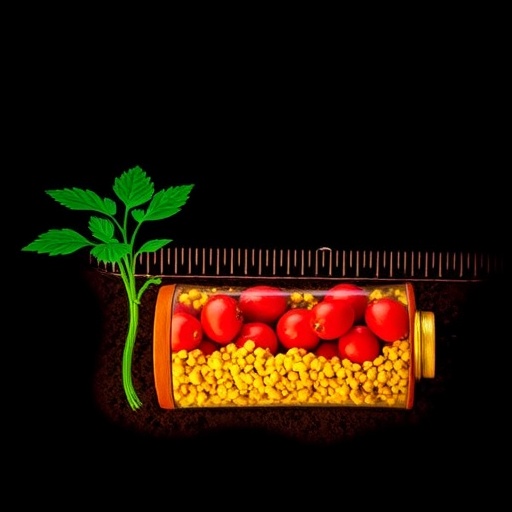Researchers have unveiled a groundbreaking innovation in the realm of environmental science that pushes the boundaries of our understanding of soil microbial interactions. A collaborative team from Kunming University of Science and Technology and the University of Massachusetts Amherst has developed an intriguing device known as a bio-photovoltage soil-microbe battery. This innovative system uniquely harnesses the power of sunlight, allowing soil microorganisms to use stored solar energy for pollutant degradation even in the absence of light. This discovery has profound implications for both microbial ecology and the remediation of environmental contaminants, particularly antibiotics prevalent in soil and water ecosystems.
The research, documented in the journal Environmental and Biogeochemical Processes, highlights an unexpected synergy between common soil bacteria, specifically Bacillus megaterium, and iron minerals. Together, these elements form a living biofilm that acts as a rechargeable geochemical capacitor. By capturing sunlight, the bacterial-iron film absorbs photons and captures electrons, storing them for use during dark periods. This ability opens up new avenues for understanding how soil microorganisms can adapt to varying light conditions, ultimately contributing to the degradation of harmful pollutants without direct sunlight.
In an experimental setup, the researchers subjected a composite material made of Fe₂O₃ and B. megaterium to light-dark cycles to evaluate its performance. The results were remarkable; the system was able to generate an accumulated charge of 8.06 microcoulombs per square centimeter. What was particularly impressive was its capability to degrade as much as 22 percent of antibiotic contaminants like tetracycline and chloramphenicol in the absence of light. This statistic is noteworthy, underscoring how longer exposure to light significantly enhances degradation performance by up to 67 percent compared to limited light exposure.
At the heart of this innovative mechanism lies the cycling of iron between its Fe(II) and Fe(III) states, facilitated by bacterial metabolism. This dual state enables a redox relay that is crucial for electron storage and controlled release, forming a stable and effective power source for biochemical processes occurring during dark phases. The researchers conducted extensive electrochemical analyses, confirming that the interaction at the mineral-microbe interface improves charge transfer while minimizing energy losses. As a result, this composite not only serves as a battery but also as a biological pseudocapacitor that can sustain vital ecological processes.
The ecological implications of this research are vast, suggesting that similar mineral-microbe systems may act as a hidden yet essential component of energy cycles across various ecosystems. By functioning like natural batteries, these organisms and minerals could play a pivotal role in biogeochemical cycles, potentially transforming how we understand the functioning of soil microbiomes. Not only do these findings offer insights into the complexities of microbial life, but they also hold promise for developing environmentally friendly approaches to remediate contaminated soils and groundwater.
Professor Bo Pan, co-corresponding author from Kunming University of Science and Technology, emphasized the significance of these findings, illustrating how this system can harness solar energy during daylight hours for pollutant removal during nighttime. This unique capacity has compelling applications in the restoration of ecosystems compromised by pollution. Furthermore, it hints at the potential for biotechnological advancements that could utilize such systems for efficient environmental clean-up strategies globally.
Professor Baoshan Xing from the University of Massachusetts Amherst also underscored the discovery’s relevance to soil ecology, noting that it provides new insights into how solar energy can influence biogeochemical processes occurring beneath the soil surface. The findings advocate for a deeper recognition of the importance of microorganisms in regulating environmental health, particularly in areas where conventional remediation methods may be inadequate.
Furthermore, this research paves the way for future investigations into the role of similar microbial-mineral ensembles in energy cycling and pollutant degradation across a broader spectrum of environmental settings. With a growing body of evidence suggesting that such systems may be more widespread globally, researchers are encouraged to explore the potential applications and ecological consequences of these interactions further.
In conclusion, the innovative bio-photovoltage soil-microbe battery represents a significant leap in our understanding of microbial ecology and environmental science. It opens doors to novel strategies for addressing pressing environmental challenges related to pollution and sustainable resource management. As research continues to unravel the complexities of these microbial systems, the implications for both science and environmental stewardship remain profoundly promising.
Understanding the nuances of this technology could contribute to developing new bioremediation strategies that utilize the inherent capabilities of microbial communities. Given the urgency to combat antibiotic pollution and its impacts on both human health and ecosystems, the future implications of this research deserve attention from both ecological and industrial stakeholders aiming to foster a sustainable future.
By coupling microbial metabolism with renewable energy capture, this research not only exemplifies the ingenuity found in nature but also propels us toward innovative solutions that harmonize human activities with ecosystem preservation. Researchers are optimistic that in the near future, such biotechnological advancements could be implemented on a larger scale, highlighting the critical interconnections between biological discoveries and environmental sustainability.
This revolution in soil-microbe interaction research has the potential to redefine our approaches to pollution management globally, providing exciting new paths for inquiry in the scientific community. The journey does not end here; rather, it marks the beginning of an exciting chapter that bridges biology, chemistry, and environmental science for the betterment of our planet.
Subject of Research: Not applicable
Article Title: A bio-photovoltage soil-microbe battery for antibiotic degradation in the dark
News Publication Date: 15-Sep-2025
Web References: Environmental and Biogeochemical Processes
References: Li S, Chen Y, Wu M, Zhang P, Cui P, et al. 2025. A bio-photovoltage soil-microbe battery for antibiotic degradation in the dark. Environmental and Biogeochemical Processes 1: e004
Image Credits: Shunling Li, Ye Chen, Min Wu, Peng Zhang, Peng Cui, Wenyan Duan, Bo Pan, & Baoshan Xing
Keywords
Tags: antibiotic degradation in soilBacillus megaterium and iron mineralsbio-photovoltage soil-microbe batterydark period pollutant degradationenvironmental remediation technologiesinnovative environmental science researchlight-dark cycle experiments in soilmicrobial ecology advancementsrechargeable geochemical capacitorssoil bacterial biofilm synergysoil microbial interactionssunlight energy in soil





